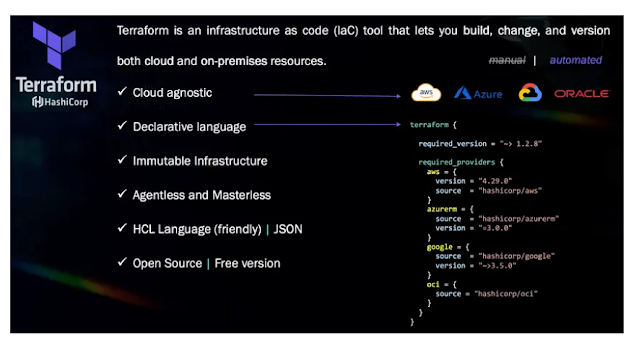 |
| https://www.terraform.io |
Given the era of agile development as well as cloud adoption, it has become more than essential to manage infrastructure efficiently and consistently. If not carefully managed, typical manual configurations will result in mistakes, disparities and slow deployments that impede progress and innovation. The good news is that Terraform has emerged as a game changer by providing a declarative approach to Infrastructure as Code (IaC) which is automated in nature.
Unveiling Terraform's Core:
 |
| https://pisquare.fr |
Benefits that Propel Terraform Forward:
 |
| https://www.businessprocessincubator.com |
1. Consistency and reusability:
Terraform, an infrastructure as code tool, ensures that all deployments match the defined state and avoids human error during deployment. This helps to reduce risk and make things more predictable.
2. Automation Mastermind:
In comparison to manual configurations, Terraform saves time and effort in automating infrastructure provisioning and management leading to valuable resources being channeled into core development activities.
3. Version Control Hero:
You can track changes, revert to previous versions or collaborate effectively within teams as terraform’s configuration seamlessly combines with version control systems. This promotes openness in the process of resolving issues.
4. Multi-Cloud Wizardry:
Terraform accommodates numerous cloud providers and platforms allowing for infrastructure management across different environments and thereby eliminating vendor lock-in by increasing flexibility.
5. Advantage of Declarative Management:
Unlike imperatives that tell how the desired state is achieved, terraform only describes what is expected. Instead of telling you how to achieve it, this approach allows the tool to figure out what steps are required for attaining it resulting in a more declarative way of managing infrastructure.
Embarking on the Terraform Journey:
 |
| https://www.linkedin.com |
1) Setup:
 |
| https://www.whizlabs.com |
Get Terraform on your operating system by downloading and installing it from the official page (https://developer.hashicorp.com/terraform/install).
2) Configuring Craft:
 |
| https://blog.stackademic.com |
Use HCL in a .tf file to define your infrastructure resources. The type, name, and configuration options for the desired resource are specified in each resource block.
3) Initial Preparation:
 |
| https://aws.amazon.com/blogs |
Run terraform init so that you can download and install any required plugins for the cloud provider you have chosen.
4) Anticipate Future Changes:
You need to review them through running terraform plan before applying any changes. This way, you will be able to see what impact these modifications will have on your account.
5) Making the Changes Take Place:
In order to create or modify your infrastructure as per the approved plan perform terraform apply.
Beyond the Basics: Unveiling Advanced Features:
 |
| https://medium.com/@sampathbhargav |
Although Terraform’s core features are simple, it has numerous advanced options for managing sophisticated infrastructures:
a) Modular Magic:
 |
| https://teckdebate.medium.com |
Start breaking down your infrastructure into reusable modules. This improves code organization, maintainability as well as sharing across projects.
b) State Management Mastery:
 |
| https://blog.gruntwork.io |
The current condition of your infrastructure is stored by Terraform in a state file. Consequently, you can implement changes, manage the infrastructure even across various environments and collaborate effectively.
c) Remote State Backends:
 |
| https://medium.com/devops-mojo |
Secure and make collaboration easier by storing your Terraform state in remote services such as cloud storage or database.
d) Provider Power:
 |
| https://www.whizlabs.com |
Plugin support is also available for each cloud provider that extends the capability of using unique functions on specific providers.
Learning Resources to Fuel Your Journey:
HashiCorp provides a complete documentation, tutorials, and a thriving user forum to help you explore Terraform. Also, find useful material such as blogs, open-source modules and community forums that can provide insights and best practices.
Conclusion: A Transformative Approach to Infrastructure Management:
The management of infrastructure has been totally changed by Terraform through its approach that is declarative, automatic and uniform. It is a must-have tool for any business regardless of size because it can be conveniently employed in various platforms and offers attractive features. If you are a seasoned developer or even if you are new to Infrastructure as Code (IaC), this allows you to efficiently construct and oversee your infrastructures in a dependable and scalable fashion.
